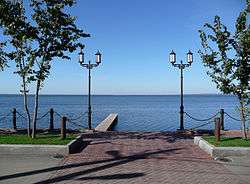Lake Pleshcheyevo
| Lake Pleshcheyevo | |
|---|---|
 | |
 Location in Russia | |
| Location | Yaroslavl Oblast |
| Coordinates | 56°45′59″N 38°47′04″E / 56.76639°N 38.78444°ECoordinates: 56°45′59″N 38°47′04″E / 56.76639°N 38.78444°E |
| Basin countries | Russia |
| Surface area | 51 km² |
| Settlements | Pereslavl-Zalessky |
Lake Pleshcheyevo (Russian: Плеще́ево о́зеро), a lake in Russia, and formerly a resort for Russian tsars, is located in Yaroslavl Oblast. The town of Pereslavl-Zalessky is on the southeastern side of the lake.[1]
The lake, which is part of Pleshcheyevo National Park, covers an area of over 51 km², its length being 9.5 kilometres (5.9 mi) and its shoreline 28 kilometres (17 mi). Although it is 25 metres (82 ft) deep in the middle, the waters near the shore are quite shallow. The lake is well known for camping, swimming, and fishing.
One of Lake Pleshcheyevo's inhabitants is the vendace or "freshwater herring" (ryapushka in Russian). The city of Pereslavl's coat of arms has two golden ryapushka on a black ground. This town was known in the Middle Ages for exporting smoked ryapushka, which was the favorite fish at the Tsars' table.
History
Located on the shore is a legendary twelve-ton boulder, the "Blue stone", which was worshipped by pagans in centuries past, and is still a venue for celebrating Russian Orthodox holidays. In 1688–1693, Peter the Great built his famous "funny flotilla" (i. e. training flotilla) on Lake Pleshcheyevo for his own amusement, including the so-called Peter's little boat, which would be considered one of the forefathers of the Russian fleet. The Botik (small boat) museum in Pereslavl-Zalessky chronicles the history of the first Russian fleet and keeps one of the original ship models.[2]
in 1925 author Mikhail Prishvin spent a year at a research station near the lake and wrote up his observations of the landscape in the widely admired Springs of Berendey.[3]
Lake Pleshcheyevo is now a protected area under the Pereslavl Governmental Nature-Historical Natural Park authority.
See also
References
- ↑ Lake information: Botik
- ↑ Peter the Great's "poteshny" (toy) fleet
- ↑ Родники Берендея (1925–26), enlarged and published as Nature's Diary/ Календарь природы (1935).
External links
-
 Media related to Lake Pleshcheyevo at Wikimedia Commons
Media related to Lake Pleshcheyevo at Wikimedia Commons - First-Class Camping & Hiking